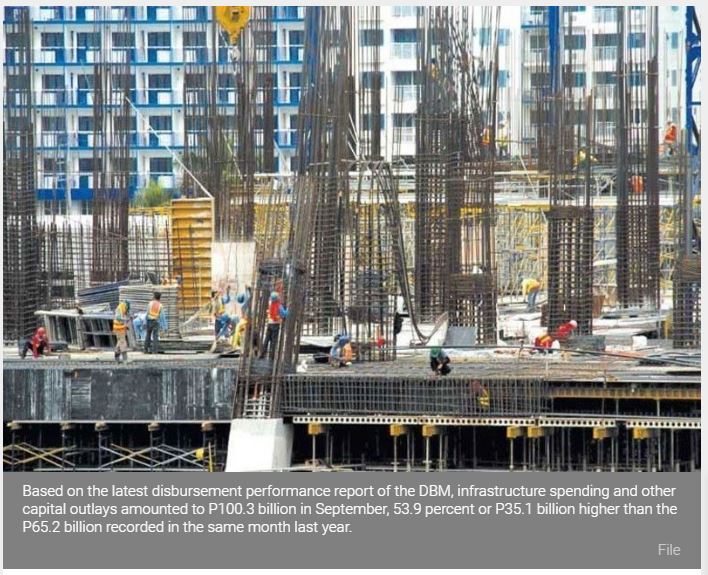Philippines: Infrastructure spending surges 54% in September
MANILA, Philippines —Public spending on infrastructure surged by 54 percent in September as state agencies fast-tracked the implementation of projects as part of their spending catch-up measures, the Department of Budget and Management (DBM) reported yesterday.
Based on the latest disbursement performance report of the DBM, infrastructure spending and other capital outlays amounted to P100.3 billion in September, 53.9 percent or P35.1 billion higher than the P65.2 billion recorded in the same month last year.
This has been the fastest pace of growth for infrastructure spending in the first nine months, following a lag in the first half due to the delay in the passage of the 2019 budget and the election ban on public works.
According to the DBM, the strong growth in infrastructure disbursements came after the full and partial implementation of projects by the Department of Public Works and Highways, such as the construction, upgrading, repair and rehabilitation of roads, bridges and flood control structures.
The agency also attributed this to the purchase of new military equipment under the Revised Armed Forces of the Philippines Modernization Program of the Department of National Defense, and the construction of the new Supreme Court building.
However, DBM data also showed that while monthly infrastructure expenditures rose, year-to-date infrastructure spending was still 8.1 percent lower compared to the P594.5 billion target, reaching P546.3 billion as of end-September. This is likewise 4.3 percent lower than the P570.8 billion posted in the same nine-month period last year.
Including equity and capital transfer to local government units, the DBM said total capital outlays for September jumped by 57.2 percent to P122.6 billion from P78 billion in the same month in 2018.
This brought cumulative capital outlays for the nine-month period to P661 billion, 8.6 percent below the P723.5 billion program.
According to the DBM, the surge in capital outlays in September drove the 39 percent growth in overall government disbursements, which reached P415.1 billion compared to P298.6 billion in the same period last year.
On a year-to-date basis, the national government’s disbursement amounted to P2.63 trillion as of end-September, which is 5.5 percent up from last year, but 2.1 percent short of program.
The DBM said this indicates that “the government has broken through the effects of the delayed passage of the fiscal year 2019 national budget and the election ban on infrastructure spending, which weighed down on economic growth during the first half of the fiscal year.”
“Following this latest development, the DBM is optimistic that the national government will be able to meet its catch-up spending program before the end of the fiscal year in support of the administration’s growth targets,” it added. The government has a spending program of P3.77 trillion for full-year 2019.
Given faster spending, Michael Ricafort, head of the Economics and Industry Research Division of the Rizal Commercial Banking Corp., said economic growth in the third quarter may settle at a faster pace of 6.3 percent compared to the four-year low of 5.5 percent in the second quarter and 6.2 percent in the third quarter of last year.
“This is largely brought about by the dramatic increase in government spending, especially on infrastructure as the government’s catch-up spending for the rest of 2019 is finally taking place and already breaking away or shifting from the lingering slowdown in government spending,” Ricafort said in an email.
He said this may continue for the rest of the year, with at least a six percent gross domestic product (GDP) growth in the fourth quarter, especially if the strong growth in government spending is sustained.
Source: https://www.philstar.com/business/2019/11/01/1964969/infrastructure-spending-surges-54-september#m9stPqtDCA8B2YSt.99


 Thailand
Thailand




